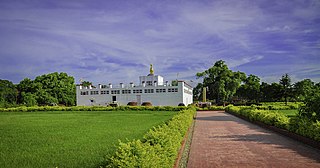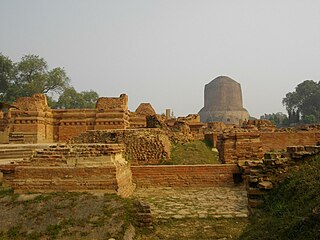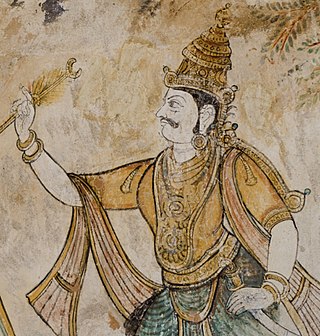
Lumbinī is a Buddhist pilgrimage site in the Rupandehi District of Lumbini Province in Nepal. According to the sacred texts of the Buddhist Commentaries, Maya Devi gave birth to Siddhartha Gautama in Lumbini in c. 624 BCE. Siddhartha Gautama achieved Enlightenment, and became Shakyamuni Buddha who founded Buddhism. He later passed into parinirvana at the age of 80 years, in c.544 BCE. Lumbini is one of four most sacred pilgrimage sites pivotal in the life of the Buddha.

Sarnath is a town located 8 kilometres northeast of Varanasi, near the confluence of the Ganges and the Varuna rivers in Uttar Pradesh, India. According to the Lalitavistara sutra, the Gautama Buddha chose "Deer Park by the Hill of the Fallen Sages, outside of Varanasi" for the location of his first teachings of Buddhism, known as the Dhammacakkappavattana sutra, after he attained enlightenment at Bodh Gaya. It is one of eight most important pilgrimage sites for Buddhists, and has been nominated to become a UNESCO World Heritage Site.

Sanchi Stupa is a Buddhist complex, famous for its Great Stupa, on a hilltop at Sanchi Town in Raisen District of the State of Madhya Pradesh, India. It is located, about 23 kilometers from Raisen town, district headquarter and 46 kilometres (29 mi) north-east of Bhopal, capital of Madhya Pradesh.
Aragalur is a village in Salem district, Tamil Nadu, India. It is about 6 km from Thalaivasal and 70 km from Salem.

Rajaraja I, also known as Rajaraja the Great, was a Chola emperor who reigned from 985 CE to 1014 CE. He is known for his conquests of southern India and parts of Sri Lanka, and increasing Chola influence across the Indian Ocean. Rajaraja's birth name was Arulmozhi Varman.
Rajendra I, often referred to as Rajendra the Great, Gangaikonda Cholan, and Kadaram Kondan, was a Chola Emperor who reigned from 1014 and 1044 CE. He was born in Thanjavur to Rajaraja I. His queen was Vanavan Mahadevi and he assumed royal power as co-regent with his father in 1012 until his father died in 1014, when Rajendra ascended to the Chola throne.

Chola Nadu is an ancient region spanning on the current state of Tamil Nadu and union territory of Puducherry in southern India. It encompasses the lower reaches of the Kaveri River and its delta, and formed the cultural homeland and political base of the Chola Dynasty which ruled large parts of India and Sri Lanka between the 9th and 13th centuries CE. Uraiyur served as the early Chola capital, then medieval Cholas shifted to Thanjavur and later cholas king Rajendra Chola I moved the capital to Gangaikonda Cholapuram in Ariyalur district in the 11th century CE. Chola Nadu is therefore larger than the Tanjore region or the Cauvery delta in the strict sense. Although it essentially corresponds to these two overlapping areas.
Gudiyetram, colloquially Gudiyattam is a municipality in Vellore district in the state of Tamil Nadu in India. It lies between Bangalore and Chennai and the district of Vellore is 33 km away from the town. In 2011, the town had a population of 235,672. The municipality derives its name from 'Gudiye-tram' in Tamil which means habituation of people. The ancient occupation of the people of Guidyatham was handloom weaving.

Temple cars or Temple chariots are used to carry representations of Hindu deities around the streets of the temple on festival days. These chariots are generally manually pulled by the devotees of the deity.

The period of the imperial Cholas in South India was an age of continuous improvement and refinement of Chola art and architecture. They utilised the wealth earned through their extensive conquests in building long-lasting stone temples and exquisite bronze sculptures, in an almost exclusively Dravidian cultural setting.

Cuddalore District is one of the 38 districts in the state of Tamil Nadu in India.
Kadava was the name of a Tamil ruling dynasty who ruled parts of the Tamil country during the thirteenth and the fourteenth century. Kadavas were related to the Pallava dynasty and ruled from Kudalur near Cuddalore in Tamil Nadu. Hiranyavarman, the father of Nandivarman II Pallavamalla is said to have belonged to the Kadavakula in epigraphs. Nandivarman II himself is described as "one who was born to raise the prestige of the Kadava family". Chiefs bearing the Kadava title figure as feudatories of the Cholas as early as the 12th century. During the reign of Kulothunga Chola II, there was a vassal called Alappirandan Elisaimohan alias Kulottungasola Kadavaradittan. The Kadava kingdom was at the height of their power briefly during the reigns of Kopperunchinga I and Kopperunchinga II. These two rulers were powerful enough to challenge the waning Chola dynasty during the reign of Rajaraja Chola III and Rajendra Chola III. The two Kopperunchingas have left a large number of inscriptions mostly in the North and South Arcot districts and in the Chengalpattu district.
Vira Narasimha II was the Hoysala king of Kuntala from 1220 until 1234, with his kingdom located in what is now Karnataka in India. During his reign the Hoysalas gained much influence in the affairs of the Tamil country. He defeated the Kadavas and Pandyas and levied a tribute. He acted as a support to Chola king Rajaraja Chola III, who was possibly his son-in-law, against Pandya incursions. During his rule, Vira Narasimha made Kannanur Kuppam near Srirangam his second capital, with an intent to maintain close watch and control over affairs in Tamil country. Later he fought for the Chola cause again and marched all the way to Rameswaram. The Kannada poet Sumanobana was the court poet of King Vira Narasimha II.
PerperiyanKuppam (PPK), also known as Kallodaavi among neighboring peoples, is a village in Panruti, in the western end of Cuddalore District of Tamil Nadu State, India.
The Bana or Vana was a dynasty based in South India, who claimed descent from king Mahabali. The dynasty takes its name from Bana, the son of Mahabali. The Banas faced opposition from several neighbouring dynasties and served some major dynasties such as the Chalukyas Cholas and Pandyas as feudatories, sometimes after they were subjugated by them. They also served as Samantas to some dynasties. The Banas had their capital at various places at different times, including Kolar and Gudimallam. The Banas were a native Kannada ruling dynasty.
Kamakkapalayam is a village in Salem district, Thalaivasal block in the Indian state of Tamil Nadu.

Vallavaraiyan Vandiyadevan was a general of the Chola Army. He was one among the famous chieftains of the Chola emperors Rajaraja I and Rajendra I and chief of the Samanthas of Chittoor and also the husband of Rajaraja's elder sister Kunthavai Pirattiyar. He was also the chieftain of the Sri Lanka Front Army of Rajaraja l and Rajendra I. Territory under his authority was known as Vallavaraiyanadu. He ruled Brahmadesam. Vandiyathevan is idealized in Kalki Krishnamurthy's (Kalki) famous novel Ponniyin Selvan and also in many other novels like Vandiyadevan Vaal, Vandiyadevan Senai Thalaivan.

The Vellar River is a river in the Indian state of Tamil Nadu. It originates in the Kalrayan Hills, and flows generally eastward through Salem, Perambalur, and Cuddalore districts, before flowing into the Bay of Bengal near Parangipettai. The river has a total length of 150 kilometres (93 mi), and its drainage basin covers an area of 7,504.346 square kilometres (2,897.444 sq mi) in Cuddalore, Perambalur, Salem, Kallakurichi, Ariyalur, Namakkal, Tiruchirappalli, and Dharmapuri districts.

The Medieval Chola emperor Rajendra Chola I led an Chola Expedition of the Ganges between 1019 and 1021. The expedition traversed the states of Vengi, Kalinga, Madhya Pradesh, Jharkhand, Odisha, Bengal, Bihar and Uttar Pradesh culminating with their arrival at the Ganges river. The Chola victory over the Pala king Mahipala I is considered to be the climax of the expedition. In 1019 CE, Rajendra's forces marched through Kalinga towards the river Ganga. In Kalinga the Chola forces defeated Indraratha the ruler of the Somavamsi dynasty. The Chola army eventually reached the Pala kingdom of Bengal where they defeated Mahipala. The Chola army also defeated the last ruler of the Kamboja Pala dynasty Dharmapala of Dandabhukti. The Chola army went on to raid East Bengal and defeated Govindachandra of the Chandra dynasty and invaded Bastar region.

Sirpur Group of Monuments are an archaeological and tourism site containing Hindu, Jain and Buddhist monuments from the 5th to 12th centuries in Mahasamund district of the state of Chhattisgarh, India. Located near an eponymous village, it is 78 kilometres (48 mi) east of Raipur, the capital of the state. The site is spread near the banks of the river Mahanadi.